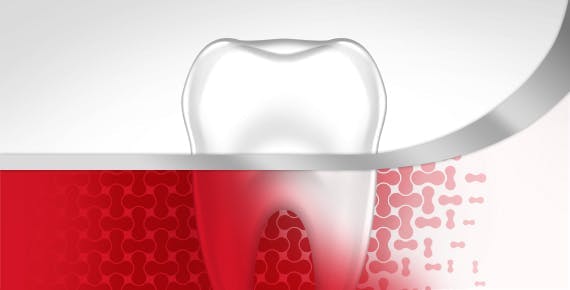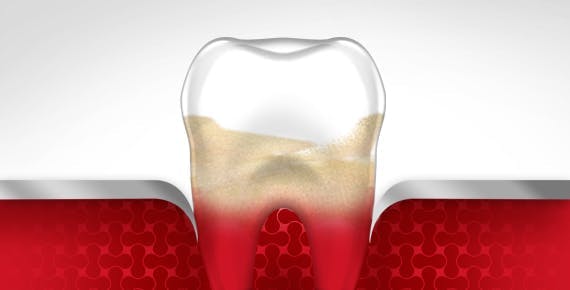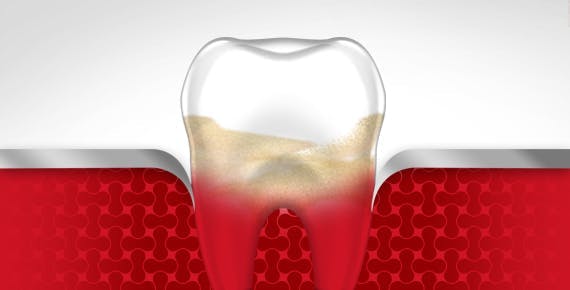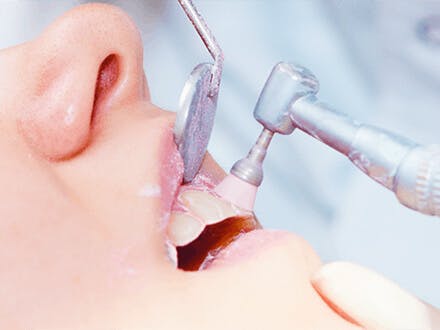Your gums are a big part of a healthy mouth, so it's essential to take good care of them throughout your life. Poor oral hygiene can lead to gum disease (also known as periodontal disease) – a progressive condition that can ultimately result in tooth loss.i If caught early, gum disease can be reversed and further damage can be prevented.ii, iii Knowing the signs of each of the four gum disease stages can help you to halt the condition before severe or lasting damage is done.
What Are the Stages of Periodontal Disease?
Stage 1: Gingivitis

Gingivitis is a mild form of gum disease that results in redness, swelling, and bleeding of the gum tissue. Gingivitis is caused by a build-up of plaque – a sticky bacterial film that collects on your teeth, gums and oral tissues.i, iii If not removed by regular brushing and flossing, plaque can harden into tartar. Both plaque and tartar can then build up along and under the gum line, and may irritate your gums and lead to gum inflammation.i
One of the most visible signs of gingivitis is the presence of blood when you brush or floss your teeth.i, iii Your gums may change color from their usual, healthy pale pink to a darker pink, red or purple.i
The good news is, you can help reverse the effects of gingivitis if you take action early on. You can do this with twice-daily brushing and flossing, and visiting your dentist for a professional cleaning.iii If left untreated, however, it can progress to cause more serious oral health problems.i,ii
If you spot signs of the early stages of periodontal disease, visit a dental professional for treatment and advice. Using a gum specific daily toothpaste such as parodontax Complete Protection can help to reverse the effects of gingivitis and promote gum health.
Stage 2: Mild Periodontitis

Gingivitis can turn into periodontitis if left untreated. This happens when the bacterial infection deepens and begins to effect the gum tissue and bone that supports the teeth.i
By the time you reach this stage of periodontal disease, it has already begun to damage the bone and gum tissue that hold your teeth in place.i
At this point, brushing alone will not treat the condition and you should see a dental professional as soon as possible. Your dentist will recommend the best treatment options for you. A professional deep clean from your dentist or a process known as ‘scaling and root planning’ can be used to remove tartar from above and below the gum line. In more advanced cases, surgery may be required.iv
Stage 3: Moderate Periodontitis

As periodontitis progresses, the gums begin to pull away from the teeth, allowing deep pockets to form below the gum line. Food debris and bacteria build up in these pockets, causing further destruction of the gum tissue and bone.i
You may notice new gaps or pus between your teeth as these pockets form, or changes to the way your teeth fit together when you bite. Other symptoms include constant bad breath, gum tenderness and bleeding, and further changes to the length, color, and feel of your teeth and gums.i
A root planning treatment may be used in addition to scaling to help halt the progression of periodontitis. Root planning smooths the rough surface of your tooth roots, making it harder for plaque to collect there.iv Surgical intervention may also be required at this stage, but your dentist will advise you on whether surgical treatment is right for you.
Stage 4: Severe Periodontitis

Severe or advanced periodontitis is the final and most extreme stage of gum disease. It occurs when periodontitis isn’t caught and treated in its earlier stages, and is the leading cause of tooth loss in adults.v
By this stage, there is so much damage to the gum tissue and jawbone that teeth can loosen and may fall out or need removing. Advanced periodontitis may also cause existing gum disease symptoms to become worse – including red, swollen and receding gums, severe bad breath, painful brushing and chewing, and gaps and pus between the teeth.i
Severe periodontitis requires surgery to clean and reduce the deep bacteria-filled pockets that have formed between the teeth. Bone and tissue grafts may also be necessary to restore a damaged mouth along with antibiotics to kill the plaque bacteria.vi If left untreated, this stage of gum disease can lead to further tooth, gum and bone loss – as well as other serious health problems.i, ii
Gum Disease Stages – Early Treatment
It's vital to tackle gum disease in its earliest stage, including bleeding and swollen gums when cleaning or flossing teeth. Use parodontax at the first sign of gum disease to help keep your gums healthy and strong.
SOURCES
- Periodontitis (Symptoms & causes). Mayo Clinic. https://www.mayoclinic.org/diseases-conditions/periodontitis/symptoms-causes/syc-20354473. Accessed 15/01/20.
- Gum Disease Information. American Academy of Periodontology. https://www.perio.org/for-patients/gum-disease-information/. Accessed 09/06/22/.
- Gingivitis. Mouth Healthy. https://www.mouthhealthy.org/en/az-topics/g/gingivitis. Accessed 07/04/20.
- Scaling and root planning. Mouth Healthy. https://www.mouthhealthy.org/en/az-topics/s/scaling-and-root-planing. Accessed 07/04/20.
- Periodontal (Gum) Disease. National Institute of Dental and Craniofacial Research https://www.nidcr.nih.gov/research/data-statistics/periodontal-disease. Accessed 15/01/20.
- Periodontitis (Diagnosis & treatment). Mayo Clinic. https://www.mayoclinic.org/diseases-conditions/periodontitis/diagnosis-treatment/drc-20354479. Accessed 07/04/20.
How parodontax Toothpaste Works
parodontaxTM is a toothpaste that is clinically proven to help reduce bleeding gums. When used twice daily, it significantly reduces plaque and bleeding gums after 12 weeks.





